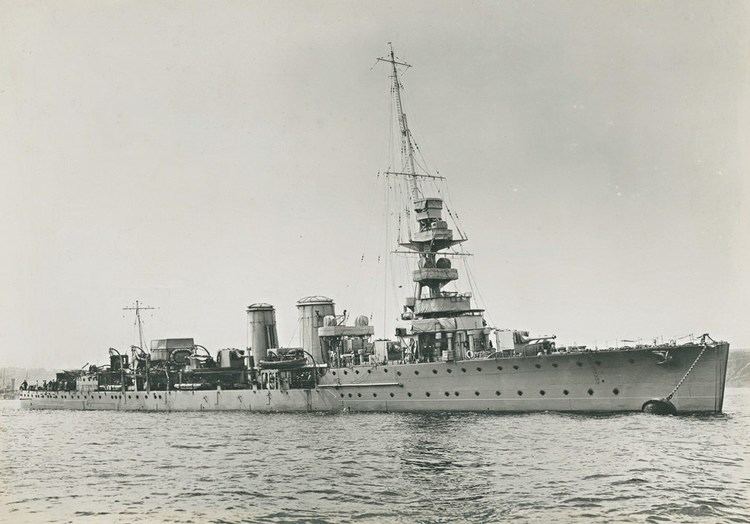Date 17 November 1917 | Result Indecisive | |
 | ||
1 light cruiser damaged 1 minesweeper sunk1 light cruiser damaged Similar World War I, Battle of Heligoland Bight, Battle of Dover Strait, Bombardment of Yarmouth, Second Ostend Raid | ||
Second battle of heligoland bight
The Second Battle of Heligoland Bight, also called the Action in the Helgoland Bight was an inconclusive naval engagement fought between British and German squadrons on 17 November 1917 during the First World War.
Contents
- Second battle of heligoland bight
- BackgroundEdit
- The BattleEdit
- British forcesEdit
- German forcesEdit
- References
BackgroundEdit
Following the German Navy's successful raid on the Scandinavian convoy on 17 October 1917, Admiral Sir David Beatty, Commander-in-Chief of the British Grand Fleet, determined to retaliate. On 17 November 1917 a strong force of cruisers under Vice Admiral Trevylyan Napier was sent to attack German minesweepers, which were clearing a channel through British minefields in the Heligoland Bight. The intentions of the German force had been revealed by British Naval Intelligence, allowing the British to mount an ambush. The German sweepers were escorted by a group of cruisers and torpedo-boats under Rear Admiral Ludwig von Reuter.
The BattleEdit
The action began at 7.30 a.m., roughly 65 nautical miles west of Sylt, when HMS Courageous sighted the enemy. She opened fire at 7:37 a.m. Admiral Reuter, the German commander, with four light cruisers and eight destroyers, advanced to engage his more powerful enemy in order to cover the withdrawal of his minesweepers, all of which escaped except for the trawler Kehdingen,(GE) which was sunk. The battle thereafter developed into a stern chase as the German forces, skilfully using smoke-screens, withdrew south-east at their best speed, under fire from the pursuing British ships of the 1st Cruiser Squadron, the 1st and 6th Light Cruiser Squadrons, and, later, HMS Repulse (which had been detached from the 1st Battle Cruiser Squadron and came up at high speed to join the battle). Both sides were hampered in their maneuvers by the presence of naval minefields.
The British ships gave up the chase some two hours later, as they reached the edge of known minefields. At about the same time, the light cruisers came under fire from two German Kaiser-class battleships, SMS Kaiser and SMS Kaiserin which had come up in support of Reuter's ships; HMS Caledon was struck by one 30.5 cm (12.0 in) shell which did minimal damage; shortly thereafter, the British forces withdrew.
All personnel on the bridge of the light cruiser HMS Calypso, including her captain, Herbert Edwards, were killed by a 15 cm (5.9 in) shell. The battle cruiser HMS Repulse, briefly engaged the German ships at about 10:00, scoring a single hit on the light cruiser SMS Königsberg that ignited a major fire on board.
It was during this battle that Able Seaman John Henry Carless of HMS Caledon won a posthumous Victoria Cross for his bravery in manning a gun despite mortal wounds.
British forcesEdit
The following British vessels were engaged
1st Cruiser Squadron: Vice Admiral Trevylyan D. W. Napier CB, MVO
attached destroyers (13th Destroyer Flotilla)
Ursa (Cdr John C. Tovey)Nerissa (Lt. Cdr. Montague G. B. Legge DSO)Urchin (Lt Cdr Guy P. Bowles)Umpire (Lt Cdr Roger V. Alison DSO)6th Light Cruiser Squadron: Rear Admiral Edwyn S. Alexander-Sinclair CB MVO
attached destroyers (13th Destroyer Flotilla)
Valentine (flotilla leader; Cdr. Charles A. Fremantle)Vimiera (Cdr. Dashwood F. Moir)Vanquisher (Lt Cdr. Kenneth A. Beattie)Vehement (Lt. Vernon Hammersley-Heenan)1st Light Cruiser Squadron: Commodore Walter H. Cowan CB, MVO, DSO
attached destroyers (13th Destroyer Flotilla)
Vendetta (Cdr. Charles G. Ramsey)Medway (Lt. Cdr. Charles H. Neill James)1st Battle Cruiser Squadron (detachment): Rear Admiral Richard F. Phillimore CB, MVO
German forcesEdit
The following German vessels were engaged :
2nd Scouting Group (Rear Admiral Ludwig von Reuter) light cruisers
7th Torpedo-Boat Flotilla (KKpt Cordes)
S62 (KptLt Fink; lead boat, flotilla)G87 (OLtzS Komorowski)14th half-flotilla (KptLt Richard Beitzen)
G92 (KptLt Arthur von Killinger; lead boat, half-flotilla)G93 (KptLt Reimer)V83 (Kpt Lt Wedig von Keyserlingk)12th half-flotilla (KKpt Lahs)
V43 (OLtzS Narjes; lead boat, half-flotilla)V44 (OLtzS Kautter)V45 (KptLt Laßmann)Minesweepers
6th Minesweeper Half-Flotilla (6.Minensuchhalbflottille) (KptLt d'Ottilié): M66, M7, A36, T74, M53, M4, M3, M14th Auxiliary Minesweeper Half-Flotilla (4.Hilfsminensuchhalbflottille) (KptLt d R Joachim Löwe): A63, A68, A69, A74, A41, A522nd Auxiliary Minesweeper Half-Flotilla (KptLt d R Klose): fishing vessels6th Auxiliary Minesweeper Half-Flotilla (KptLt d R Wilke): fishing vessels4th Barrier-Breaker Group (IV. Sperrbrechergruppe) (KptLt d R Hillebrand): two vesselsGroup S, North Sea Outpost Half-Flotilla (LtzS Woldag): armed trawlers Fritz Reuter and Kehdingen(GE)4th Battle Squadron (Vice Admiral Wilhelm Souchon) detachment (KptzS Kurt Graßhoff)
attached torpedo-boats (anti-submarine escort)
S18 (KptLt Wildemann)S24 (KptLt Paschen)